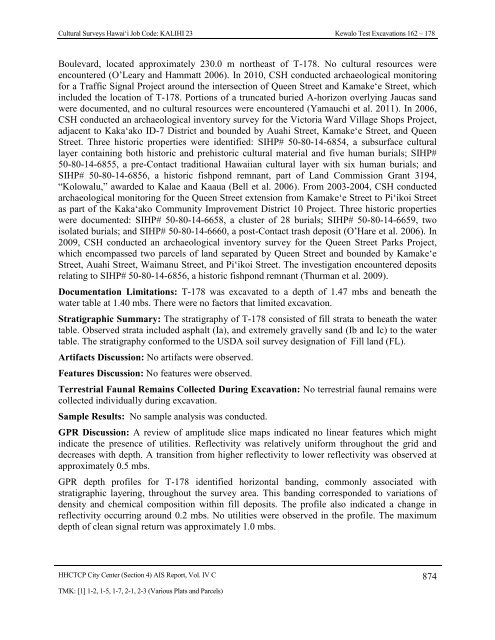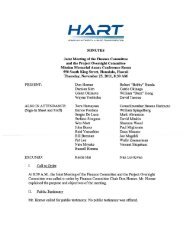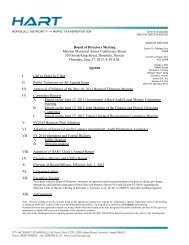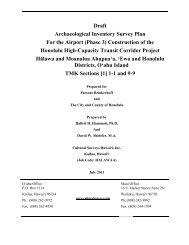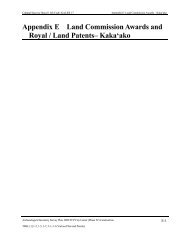4.12 Test Excavation 167 (T-167) - Honolulu Rail Transit Project
4.12 Test Excavation 167 (T-167) - Honolulu Rail Transit Project
4.12 Test Excavation 167 (T-167) - Honolulu Rail Transit Project
Create successful ePaper yourself
Turn your PDF publications into a flip-book with our unique Google optimized e-Paper software.
Cultural Surveys Hawai‘i Job Code: KALIHI 23 Kewalo <strong>Test</strong> <strong>Excavation</strong>s 162 – 178Boulevard, located approximately 230.0 m northeast of T-178. No cultural resources wereencountered (O’Leary and Hammatt 2006). In 2010, CSH conducted archaeological monitoringfor a Traffic Signal <strong>Project</strong> around the intersection of Queen Street and Kamake‘e Street, whichincluded the location of T-178. Portions of a truncated buried A-horizon overlying Jaucas sandwere documented, and no cultural resources were encountered (Yamauchi et al. 2011). In 2006,CSH conducted an archaeological inventory survey for the Victoria Ward Village Shops <strong>Project</strong>,adjacent to Kaka‘ako ID-7 District and bounded by Auahi Street, Kamake‘e Street, and QueenStreet. Three historic properties were identified: SIHP# 50-80-14-6854, a subsurface culturallayer containing both historic and prehistoric cultural material and five human burials; SIHP#50-80-14-6855, a pre-Contact traditional Hawaiian cultural layer with six human burials; andSIHP# 50-80-14-6856, a historic fishpond remnant, part of Land Commission Grant 3194,“Kolowalu,” awarded to Kalae and Kaaua (Bell et al. 2006). From 2003-2004, CSH conductedarchaeological monitoring for the Queen Street extension from Kamake‘e Street to Pi‘ikoi Streetas part of the Kaka‘ako Community Improvement District 10 <strong>Project</strong>. Three historic propertieswere documented: SIHP# 50-80-14-6658, a cluster of 28 burials; SIHP# 50-80-14-6659, twoisolated burials; and SIHP# 50-80-14-6660, a post-Contact trash deposit (O’Hare et al. 2006). In2009, CSH conducted an archaeological inventory survey for the Queen Street Parks <strong>Project</strong>,which encompassed two parcels of land separated by Queen Street and bounded by Kamake‘eStreet, Auahi Street, Waimanu Street, and Pi‘ikoi Street. The investigation encountered depositsrelating to SIHP# 50-80-14-6856, a historic fishpond remnant (Thurman et al. 2009).Documentation Limitations: T-178 was excavated to a depth of 1.47 mbs and beneath thewater table at 1.40 mbs. There were no factors that limited excavation.Stratigraphic Summary: The stratigraphy of T-178 consisted of fill strata to beneath the watertable. Observed strata included asphalt (Ia), and extremely gravelly sand (Ib and Ic) to the watertable. The stratigraphy conformed to the USDA soil survey designation of Fill land (FL).Artifacts Discussion: No artifacts were observed.Features Discussion: No features were observed.Terrestrial Faunal Remains Collected During <strong>Excavation</strong>: No terrestrial faunal remains werecollected individually during excavation.Sample Results: No sample analysis was conducted.GPR Discussion: A review of amplitude slice maps indicated no linear features which mightindicate the presence of utilities. Reflectivity was relatively uniform throughout the grid anddecreases with depth. A transition from higher reflectivity to lower reflectivity was observed atapproximately 0.5 mbs.GPR depth profiles for T-178 identified horizontal banding, commonly associated withstratigraphic layering, throughout the survey area. This banding corresponded to variations ofdensity and chemical composition within fill deposits. The profile also indicated a change inreflectivity occurring around 0.2 mbs. No utilities were observed in the profile. The maximumdepth of clean signal return was approximately 1.0 mbs.HHCTCP City Center (Section 4) AIS Report, Vol. IV C 874TMK: [1] 1-2, 1-5, 1-7, 2-1, 2-3 (Various Plats and Parcels)


